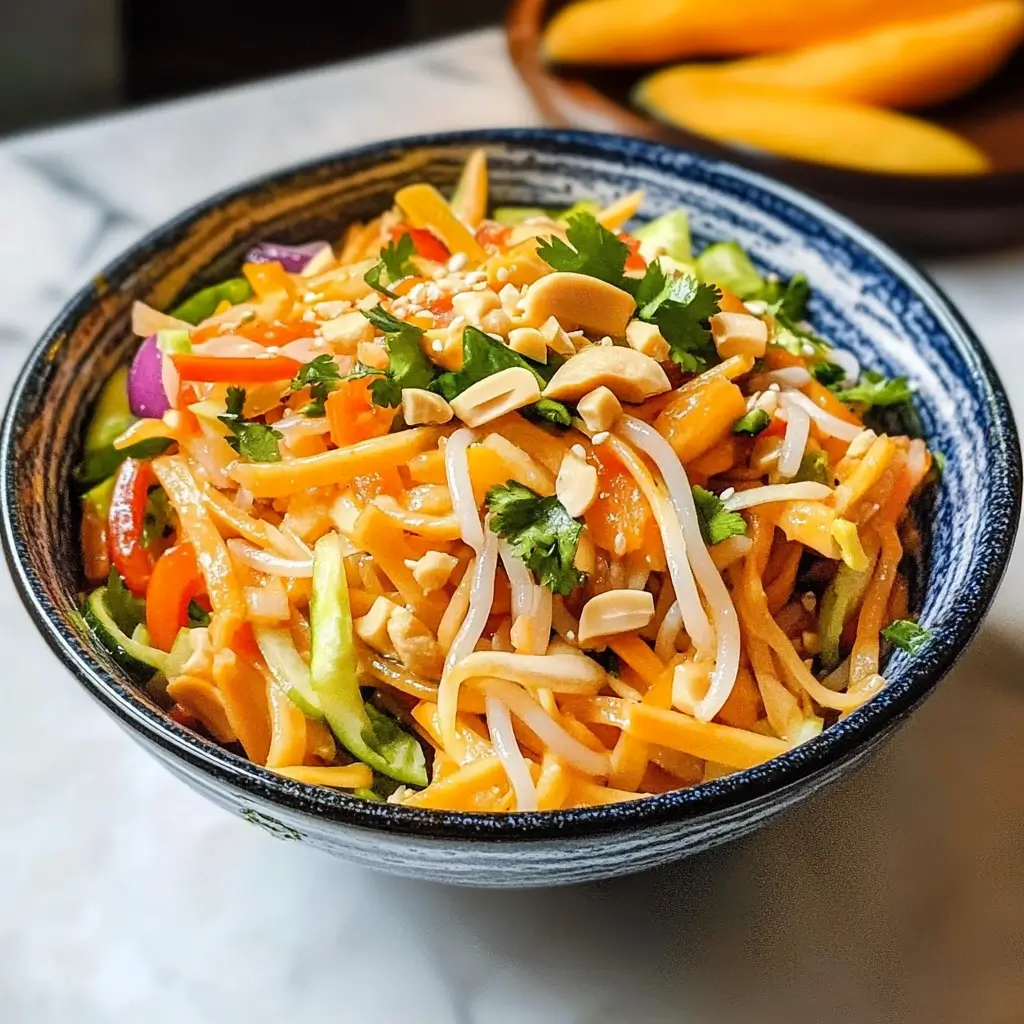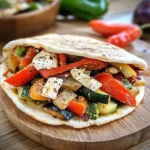Okay, let me tell you, this Peanut Noodle Salad has become an absolute sensation in my household. The first time I whipped it up, I was cautiously optimistic – noodles, peanut butter, veggies… sounded good in theory. But the reality? It blew us all away. My kids, who can be notoriously picky about anything green, were actually fighting over the last crunchy bits of bell pepper and carrot slicked with that divine peanut sauce. My husband, a man of simple culinary pleasures, declared it “restaurant-quality” and immediately requested it for his work lunches. For me, it’s the perfect storm of easy, healthy, and incredibly satisfying. It’s vibrant, packed with textures, and that creamy, nutty, slightly sweet, and tangy dressing is just pure magic. It’s become our go-to for quick weeknight dinners, impressive potluck contributions, and even just a satisfying solo lunch I can prep ahead. The aroma alone, as you whisk together that peanut sauce, is enough to make your mouth water. It’s more than just a salad; it’s an experience – a delightful dance of flavors and textures that leaves you feeling good from the inside out. This isn’t just a recipe; it’s a keeper, a crowd-pleaser, and a testament to how simple ingredients can create something truly spectacular.
Ingredients
For the Peanut Noodle Salad:
- Noodles: 12 ounces (about 340g) spaghetti, linguine, soba noodles, or ramen noodles – Cooked according to package directions, rinsed with cold water, and drained well. These form the hearty base of our salad.
- Red Bell Pepper: 1 large, thinly sliced – Adds a sweet crunch and vibrant color.
- Carrots: 2 medium, julienned or shredded – Provide sweetness, color, and a delightful textural contrast.
- Cucumber: 1 medium, seeded and julienned or thinly sliced – Offers a refreshing, cool crunch.
- Edamame: 1 cup, shelled and cooked (frozen works perfectly) – Boosts protein and adds a pleasant chewiness.
- Red Cabbage: 1 cup, thinly shredded – Lends a beautiful purple hue and a peppery crunch.
- Scallions (Green Onions): 4-5, thinly sliced (both green and white parts) – For a mild, fresh oniony bite.
- Fresh Cilantro: ½ cup, roughly chopped (plus more for garnish) – Adds a burst of fresh, herbaceous flavor.
- Roasted Peanuts: ½ cup, roughly chopped (for garnish) – Essential for that signature nutty crunch and flavor.
- Sesame Seeds: 2 tablespoons, toasted (for garnish, optional) – Adds a subtle nutty flavor and visual appeal.
For the Creamy Peanut Dressing:
- Creamy Peanut Butter: ¾ cup (natural, unsweetened preferred) – The star of the dressing, providing richness and nutty depth.
- Soy Sauce or Tamari: ½ cup (use Tamari for gluten-free) – Adds salty, umami depth.
- Rice Vinegar: ¼ cup (unseasoned) – Provides a necessary tangy brightness to balance the richness.
- Honey or Maple Syrup: 3 tablespoons (adjust to taste; use maple syrup for vegan) – For a touch of sweetness to round out the flavors.
- Toasted Sesame Oil: 2 tablespoons – Imparts a distinctive nutty, aromatic flavor.
- Fresh Lime Juice: 2 tablespoons (from 1-2 limes) – Adds a zesty, fresh tang.
- Fresh Ginger: 1 tablespoon, grated or finely minced – Brings a warm, zesty spice.
- Fresh Garlic: 2-3 cloves, grated or finely minced – Adds a pungent, savory kick.
- Sriracha or Chili Garlic Sauce: 1-2 teaspoons (or to taste, optional) – For a touch of heat, if desired.
- Warm Water: 2-4 tablespoons (or as needed to reach desired consistency) – Helps to thin the sauce to a pourable, smooth texture.
Instructions
- Cook the Noodles: Bring a large pot of salted water to a rolling boil. Add your chosen noodles (spaghetti, linguine, soba, or ramen) and cook according to the package instructions until al dente. It’s crucial not to overcook them, as they will continue to absorb a bit of moisture from the sauce and can become mushy if overdone. Once cooked, drain the noodles thoroughly in a colander and immediately rinse them under cold running water. This stops the cooking process and removes excess starch, preventing them from sticking together. Set aside to drain completely. A little toss with a teaspoon of sesame oil at this stage can also help prevent sticking if you’re not assembling immediately.
- Prepare the Vegetables: While the noodles are cooking, or while they are draining, take the time to prepare all your vegetables. Thinly slice the red bell pepper, julienne or shred the carrots (a julienne peeler or food processor shredding disk makes this quick work), seed and julienne or thinly slice the cucumber, thinly shred the red cabbage, and thinly slice the scallions. If using frozen edamame, cook it according to package instructions, then cool. Having all your veggies prepped and ready to go makes assembly a breeze. This “mise en place” step is key to a stress-free cooking experience.
- Make the Peanut Dressing: In a medium-sized mixing bowl, combine the creamy peanut butter, soy sauce (or tamari), rice vinegar, honey (or maple syrup), toasted sesame oil, fresh lime juice, grated fresh ginger, and minced fresh garlic. If you like a bit of a kick, add the Sriracha or chili garlic sauce now. Whisk all these ingredients together vigorously until the mixture is completely smooth, creamy, and well emulsified. The sauce will likely be quite thick at this point.
- Adjust Dressing Consistency: Gradually add the warm water, one tablespoon at a time, whisking continuously after each addition, until the dressing reaches your desired consistency. You’re aiming for a pourable sauce that’s thick enough to coat the noodles and vegetables beautifully but not so thick that it’s difficult to toss. It should resemble a slightly thinned-out honey or a heavy cream. Taste the dressing and adjust seasonings if necessary – you might want a little more soy sauce for saltiness, honey/maple for sweetness, lime juice for tang, or Sriracha for heat.
- Combine Noodles and Half the Dressing: In a very large mixing bowl (the largest you have!), add the cooked and well-drained noodles. Pour about half of the prepared peanut dressing over the noodles. Toss gently but thoroughly to ensure every strand of noodle is lightly coated with the sauce. This initial coating helps the noodles absorb some flavor and prevents them from clumping.
- Add Vegetables and Remaining Dressing: Add the sliced red bell pepper, julienned carrots, cucumber, cooked edamame, shredded red cabbage, and most of the sliced scallions (reserving some for garnish) to the bowl with the noodles. Pour the remaining peanut dressing over the vegetables and noodles.
- Toss to Combine: Using tongs or two large spoons, gently toss everything together until the vegetables are evenly distributed and everything is generously coated with the luscious peanut dressing. Be careful not to over-mix, as this can break down the vegetables too much. You want to maintain their satisfying crunch.
- Add Fresh Herbs: Stir in the chopped fresh cilantro, reserving a little extra for garnishing the final dish. The cilantro adds an incredible burst of freshness that cuts through the richness of the peanut sauce.
- Chill (Optional but Recommended): For the best flavor, cover the bowl and refrigerate the peanut noodle salad for at least 30 minutes before serving. This allows the flavors to meld together beautifully and the noodles to fully absorb the dressing. If you’re short on time, it can be served immediately, but the brief chilling period really enhances the taste.
- Garnish and Serve: When ready to serve, give the salad a final gentle toss (it might have settled a bit). Transfer to a serving platter or individual bowls. Garnish generously with the reserved chopped roasted peanuts, toasted sesame seeds (if using), the remaining sliced scallions, and a little extra fresh cilantro. The crunch from the peanuts is an essential finishing touch!
Nutrition Facts
- Servings: Approximately 6-8 servings
- Calories per serving: Roughly 450-550 kcal (This can vary based on noodle type, exact amount of peanut butter, and added protein.)
- Protein: Around 15-20g. Primarily from the peanut butter, noodles, and edamame, essential for muscle repair and satiety.
- Healthy Fats: Around 25-30g. Largely monounsaturated and polyunsaturated fats from peanut butter and sesame oil, beneficial for heart health.
- Fiber: Around 8-10g. Contributed by the whole-wheat noodles (if used) and the abundance of fresh vegetables, promoting digestive health and fullness.
- Carbohydrates: Around 50-60g. Mainly from the noodles, providing energy, with complex carbohydrates from vegetables offering sustained release.
- Vitamins & Minerals: Rich in Vitamin C (from bell peppers), Vitamin K (from cabbage and greens), and various B vitamins, supporting overall bodily functions.
Preparation Time
- Total Preparation Time: Approximately 30-40 minutes
- Active Prep Time: 20-25 minutes (chopping vegetables, whisking sauce). This is where most of your hands-on work will be.
- Cook Time: 10-15 minutes (boiling noodles, cooking edamame if frozen).
- Chill Time (Optional): 30 minutes to 1 hour (allows flavors to meld).
- This Peanut Noodle Salad is wonderfully efficient, coming together quickly for a satisfying meal. The majority of the time is spent on the enjoyable task of chopping colorful vegetables and whisking together the aromatic, creamy peanut dressing. It’s a perfect recipe for a weeknight when you crave something fresh and flavorful without spending hours in the kitchen.
How to Serve
This vibrant Peanut Noodle Salad is incredibly versatile and can be served in numerous delightful ways:
- As a Standalone Vegetarian/Vegan Main Course:
- Serve generously in individual bowls for a light yet satisfying lunch or dinner.
- Its combination of carbohydrates from noodles, protein from peanut butter and edamame, and healthy fats makes it a well-rounded meal on its own.
- With Added Protein for a Heartier Meal:
- Grilled Chicken or Shrimp: Top with slices of grilled chicken breast, shredded rotisserie chicken, or perfectly grilled shrimp for an extra protein punch.
- Crispy Tofu or Tempeh: For a fantastic vegan option, serve with pan-fried or baked crispy tofu cubes or tempeh strips. Marinate them in a little soy sauce and ginger first for extra flavor.
- Flaked Salmon: Cooked and flaked salmon also pairs beautifully with the nutty, savory flavors.
- As a Delicious Side Dish:
- Serve smaller portions alongside Asian-inspired main courses like teriyaki glazed salmon, satay skewers, or a light miso soup.
- It’s an excellent companion to summer barbecues, complementing grilled meats and fish.
- For Potlucks, Picnics, and Gatherings:
- This salad travels exceptionally well, making it a potluck superstar. Prepare it a few hours ahead, keep it chilled, and give it a good toss before serving.
- Pack it in individual containers for easy picnic lunches.
- Its vibrant colors and crowd-pleasing flavors are always a hit.
- Meal Prep Champion:
- Portion it into individual containers for easy grab-and-go lunches throughout the week. Keep the dressing separate if storing for more than 2-3 days and toss just before eating to maintain the best texture.
- Presentation Matters:
- Serve in a large, shallow bowl or platter to showcase all the colorful ingredients.
- Always garnish just before serving with fresh cilantro, chopped peanuts, and sesame seeds for maximum visual appeal and textural contrast.
- A drizzle of extra peanut sauce or a lime wedge on the side allows individuals to customize their plate.
- Temperature Flexibility:
- Best served chilled or at room temperature. If it has been refrigerated for a while, you might want to let it sit out for 15-20 minutes before serving, as the sauce can thicken considerably when cold. You may need to add a splash of warm water to loosen it up.
Additional Tips
- The Al Dente Difference: Why Perfectly Cooked Noodles Matter. Overcooked noodles can become mushy and lose their appealing chewiness when tossed with the sauce and vegetables, especially if the salad sits for a while. Aim for that perfect al dente bite – tender but still with a slight resistance. Rinsing with cold water immediately after draining is key to halting the cooking process.
- Sauce Consistency is Key. The perfect peanut sauce should be creamy and pourable, thick enough to coat everything beautifully but not so sludgy that it makes the salad heavy. If your peanut butter is very thick, or if the sauce seems too dense, don’t hesitate to whisk in warm water, a tablespoon at a time, until it reaches the desired consistency. Conversely, if it’s too thin, a little extra peanut butter can help thicken it up.
- Customize Your Crunch Crew. While the recipe calls for specific vegetables, feel free to get creative! Snow peas, sugar snap peas, thinly sliced radishes, yellow bell peppers, or even blanched broccoli florets would all be delicious additions. The more color and texture, the better. Think about what’s in season or what you have on hand.
- Make-Ahead Magic for Easy Entertaining. You can prepare components of this salad ahead of time. Cook the noodles, chop the vegetables, and whisk together the dressing. Store them in separate airtight containers in the refrigerator for up to 2-3 days. Combine everything an hour or so before serving to let the flavors meld. This makes it perfect for stress-free entertaining or meal prepping.
- Dial Up or Down the Spice. The recipe suggests Sriracha or chili garlic sauce for a touch of heat, but this is entirely adaptable. If you love spice, add more! You could also incorporate a pinch of red pepper flakes or a finely minced jalapeño (seeds removed for less heat) into the dressing. If you prefer no heat, simply omit it.
- The Power of Fresh: Ginger and Garlic. While powdered versions are convenient, fresh ginger and garlic impart a much brighter, more pungent, and complex flavor that truly elevates the peanut sauce. Take the extra few minutes to grate or finely mince them; your taste buds will thank you. A microplane zester is excellent for this.
- Don’t Skip the Garnish. The chopped roasted peanuts, fresh cilantro, and sesame seeds are not just for looks; they add crucial layers of texture and flavor. The crunch of the peanuts contrasts beautifully with the soft noodles and crisp-tender vegetables, while the cilantro adds a burst of freshness. Toasting the sesame seeds briefly in a dry pan enhances their nutty aroma.
- Reviving Leftovers Gracefully. If you have leftovers, the noodles might absorb more sauce and seem a bit dry the next day. To revive, simply whisk together a small amount of extra dressing (or thin out any leftover dressing with a splash of warm water or lime juice) and toss it with the salad before serving. A fresh sprinkle of cilantro and peanuts also helps.
FAQ Section
Q1: Can I make this Peanut Noodle Salad gluten-free?
A1: Absolutely! To make this salad gluten-free, ensure you use gluten-free noodles such as rice noodles (pad thai style or vermicelli work well), soba noodles made from 100% buckwheat (check packaging, as some contain wheat), or any certified gluten-free pasta. The most crucial substitution is to use Tamari instead of regular soy sauce in the dressing, as Tamari is typically brewed without wheat. Always double-check your peanut butter and other condiments to ensure they are gluten-free.
Q2: How can I make this recipe vegan?
A2: This recipe is very easily adapted to be fully vegan. The main adjustment is in the dressing: simply use maple syrup (or agave nectar) instead of honey as your sweetener. Ensure your chosen noodles are egg-free (most dried spaghetti, linguine, soba, and rice noodles are, but always check labels, especially for fresh varieties). All other listed ingredients are typically vegan, but it’s always good practice to verify labels on packaged goods like peanut butter.
Q3: How long will this Peanut Noodle Salad last in the refrigerator?
A3: When stored properly in an airtight container, this Peanut Noodle Salad will last for about 3-4 days in the refrigerator. The vegetables will gradually lose some of their crispness over time, and the noodles will continue to absorb the sauce. If you plan to store it for several days, consider keeping the dressing separate and tossing just before serving, or freshen it up with a little extra dressing or a squeeze of lime juice before eating.
Q4: Can I use a different type of nut butter if I don’t have peanut butter or have an allergy?
A4: Yes, you can experiment with other nut or seed butters. Almond butter is a popular alternative and will yield a similarly creamy, nutty sauce, though with a slightly different flavor profile. Cashew butter would also work well for creaminess. For a nut-free version, sunflower seed butter (sunbutter) or tahini (sesame seed paste) are excellent options. Tahini will give it more of a Middle Eastern or Mediterranean twist but is delicious. You may need to adjust the other dressing ingredients slightly (like sweetener or acidity) to balance the flavor of the alternative butter.
Q5: My peanut sauce is too thick or too thin. How can I fix it?
A5: This is a common and easily solvable issue! If your sauce is too thick (which can happen depending on the brand of peanut butter), simply whisk in warm water, one tablespoon at a time, until it reaches your desired pourable consistency. A little extra lime juice or rice vinegar can also help thin it while adding brightness. If the sauce is too thin, you can whisk in a bit more peanut butter to thicken it up. Chilling the sauce will also naturally thicken it.
Q6: What are the best noodles to use for this salad?
A6: You have many great options! Spaghetti or linguine are commonly used and work well because they hold the sauce nicely. Soba noodles (Japanese buckwheat noodles) offer a delightful earthy flavor and slightly chewier texture. Ramen noodles (fresh or dried, discard the seasoning packet) are also a fantastic choice. Rice noodles, like those used in Pad Thai, are excellent for a gluten-free version. The key is to choose a noodle that can stand up to the hearty sauce and vegetables without becoming too flimsy.
Q7: Can I add meat or other proteins to this salad?
A7: Definitely! This salad is a wonderful base for added protein. Grilled or shredded chicken, cooked shrimp, or pan-seared salmon are excellent choices. For plant-based protein, crispy baked or pan-fried tofu cubes, tempeh strips, or even extra edamame or chickpeas would be fantastic. Simply prepare your protein of choice and toss it in with the salad or serve it on top.
Q8: How can I make the salad spicier or less spicy?
A8: Customizing the spice level is easy. For more heat, increase the amount of Sriracha or chili garlic sauce in the dressing. You could also add a pinch of cayenne pepper, red pepper flakes, or a finely minced fresh chili (like a jalapeño or Thai chili, with or without seeds depending on your heat preference) directly to the dressing. For a milder salad, simply reduce or omit the Sriracha/chili garlic sauce entirely. Always taste and adjust to your preference.






